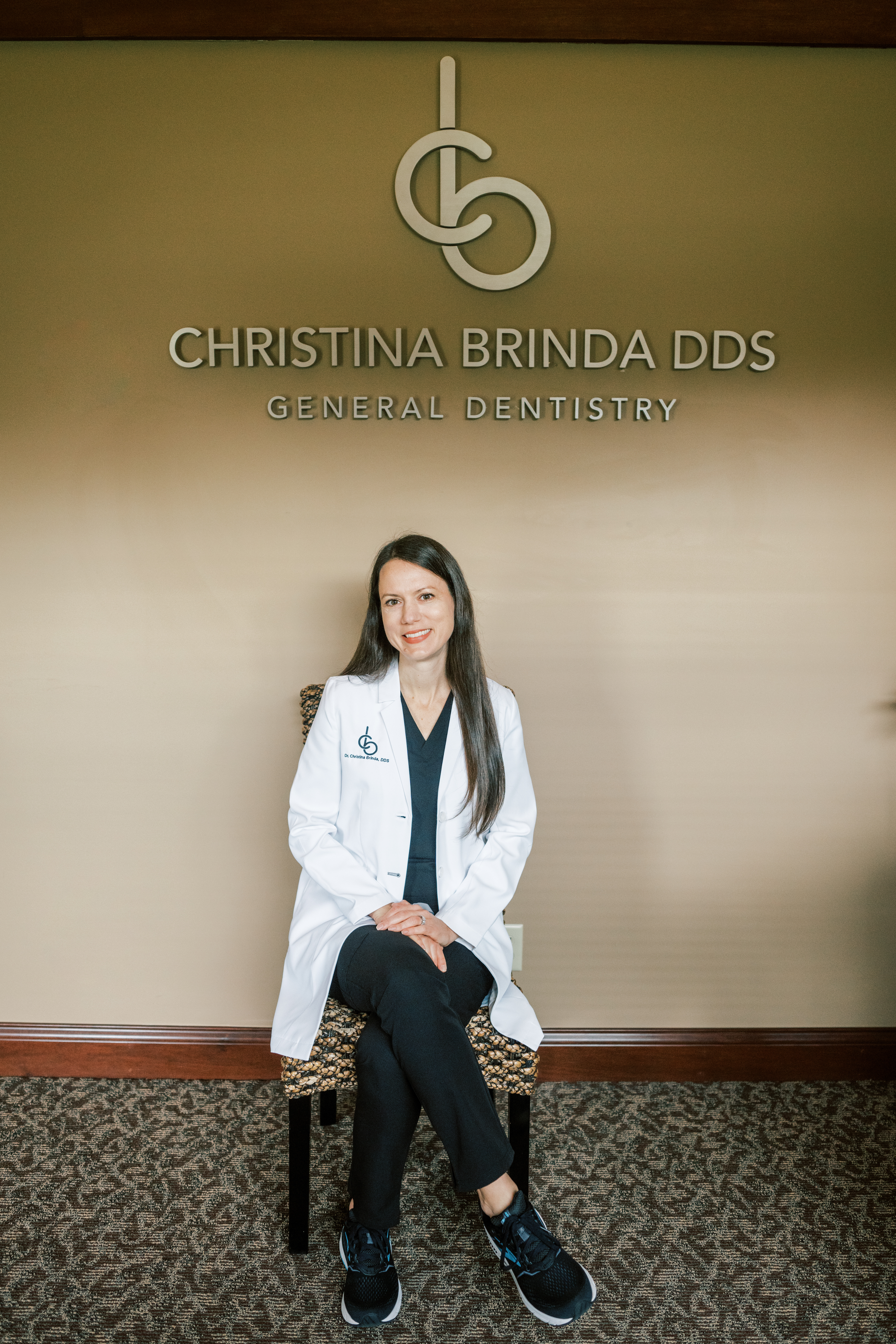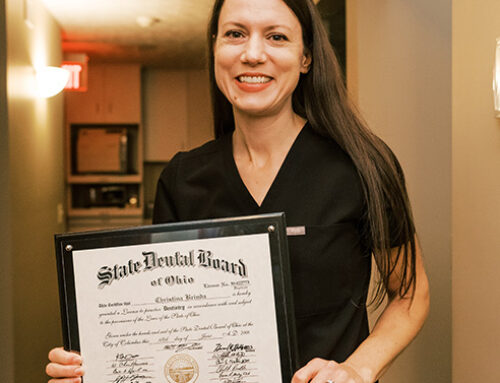A strong and healthy jawbone provides the essential foundation for successful dental implants. However, after tooth loss, the jawbone naturally begins to resorb or shrink. Often this leaves insufficient bone to support an implant. In these cases, a dental bone graft becomes a crucial preliminary procedure. At Christina Brinda DDS in North Canton, we guide our patients through every step of this process. We wish to ensure optimal conditions for your restorative journey. To help you understand every step, as your trusted North Canton Dentist, Dr. Christina Brinda and her team are here to explain what a dental bone graft entails and outline the key stages of the healing process that lead to a restored smile. At Christina Brinda DDS, we provide expert expert denture repairs in North Canton to ensure your long term oral health.
What is a Dental Bone Graft?
A dental bone graft is a minor surgical procedure used to build up bone volume in the jaw. This creates a solid foundation for a dental implant. Dr. Christina Brinda places bone grafting material. This can be derived from your own bone, a donor, an animal source or a synthetic material. Dr Christina Brinda places this material, directly into the area where the bone is insufficient. This material serves as a scaffold, which then triggers your body’s natural ability to regenerate and grow new bone cells. Once established, it strengthens your jaw.
The Healing Process: A Stage-by-Stage Guide
Once you understand the healing stages you will be able to manage expectations and ensures you are prepared for the journey ahead. While every patient heals differently, the process generally follows this timeline Dr. Brinda highlights below.
Stage 1: Immediate Post-Surgery – The First Few Days
What happens
Your body’s initial response is inflammation and clotting. A blood clot forms around the graft material is the first step in healing.
What you experience
Expect some swelling, discomfort and even some minor bleeding. This is normal. Dr. Christina Brinda will provide specific post operative instructions. Part of these instructions include pain management and soft food recommendations which are there for your comfort.
Stage 2: The First Month – Granulation and Early Bone Formation
What happens
The blood clot is gradually replaced by granulation tissue. This is a highly vascularized tissue that brings in new blood cells and the building blocks for new bone. Your body begins to break down the graft material and replace it with immature, woven bone.
What you experience
Swelling and initial discomfort will subside. You can typically begin to resume normal eating habits but this is where you still need to be careful. It’s vital to keep the area clean and avoid disturbing the graft site.
Stage 3: The Following Two to Six Months – Bone Maturation and Consolidation
What happens
This is the crucial phase where the immature bone is remodeled and replaced by strong and mature lamellar bone. The graft material fully integrates with your natural jawbone. This integration creates a dense and stable structure. This process is called osseointegration and is essential for the success of the upcoming dental implant.
What you experience
You will feel back to normal. Even so, the internal healing process is still ongoing. Dr. Brinda will schedule follow-up appointments, often via X-rays to monitor the bone growth. Additionally, with the help of these X-rays, Dr. Christina Brinda will determine when the site is ready for implant placement.
Stage 4: After 3–9 Months – Final Healing and Implant Placement
What happens
The bone graft has now healed completely. This provides a sufficient quality and quantity of bone to support the implant post.
What you experience
Dr. Brinda will confirm that the bone is strong enough. Eventually, you are ready for the next step: the placement of your dental implant.

The Foundation for a Permanent Solution
While a dental bone graft adds time to the implant process. However, it is an invaluable investment. It transforms patients from being not a candidate for implants into successful, long-term candidates. Once your implant is placed and restored with a crown or implant-supported dentures, the presence of the implant post stimulates the new bone. This helps prevent future bone loss. A bone graft is the critical first step toward a stable and lasting smile.
📞 Call our North Canton office today at (330) 498-0668 to schedule an appointment.

Ryan F.

Daniella S.
General Dentist Brinda is the best dentist I ever been to . If you’ve been holding off going to the dentist, whether for just cleaning or getting wisdom teeth out , go here . The staff is so welcoming and friendly and Dr. Brinda is so knowledgeable and walked me through every procedure from start to finish and all the expectations. She is a perfectionist that wants you to look your best and goes out of her way to do just that . I went in for a whitening treatment and cleaning and it was the best experience that I had at a dental practice! I definitely recommend this place to anyone looking to feel comfortable,well cared for and informed, while receiving best treatment for their smile.

Sorin B.
Dr. Brinda is hands down the best dentist I’ve ever been to! My wife and I live in Michigan and we make the drive every year to go see her because she’s that good! Whether it’s going in for cleaning/whitening or taking care of a cavity, I always have a great experience going here. I’ve never really enjoyed going to the doctor for anything, but I can honestly say I enjoy coming here for my yearly checkups. Dr. Brinda is very knowledgeable and extremely professional, and she goes out of her way to make people feel welcome and cared for. Highly highly recommend!

Ronald V.

Karen M.

David J.

Dan E.

Ms Lux
Dr. Brinda and her amazing office team are lovely; down to earth and outstandingly competent. Their main focus, I have no doubt from all of my visits, is their patient’s oral health. This team is professional and efficient, but also what we all want in a medical team of any sort, very knowledgeable. I truly appreciate all of the care and concern this office has offered me. This is truly a top notch team and one you can thoroughly entrust with your dental health. Thank you to you all.

Ty H.

Ty H.

Nathan C.

Angela P.

Leah K.

Sonya S.

Max P.

Jessica L.

Liv M.

Scott J.

Katherine G.

Calle S.

Beth S.

Tierra M.

Amy R.

Barbara F.

Katie M.

Myah W.

George M.

Barbara F.

Madison S.
I personally was shadowing Dr. Brinda's office for my Dental Hygienist Program, and it was an amazing experience! Dr.Brinda and her wonderful team are constantly working to make sure things are sterilized, wiped down, and organized for your visit! There was nobody sitting around, but everyone was helping other people out! Staff at Dr. Brinda's office was respectful, sweet and supportive! Dr. Brinda personally took time with patients, and treated them like a person, not just a patient. She asked recurring patients about an update on their personal lives from the patients last visit, and it was amazing to see the patients smile when she remembered. Overall, from someone who saw behind the scenes of this office, I would gladly come there to visit just to see the amazing work they do. I highly recommend Dr. Brinda's Office!

Rana Q.

Amy R.

Beth S.

Devin K.

Monica L.

Donald W.

Angela D.

Sebastian K.

Zara W.

Caleb M.

Amy S.

Matt W.

Chris L.

Efrain A.
My oldest started at 1 1/2 - 2 years old and now is 16. All are very happy with Dr. Brinda as well as the staff. Very caring and always explain what is going on when performing dental work beyond basic cleanings. Great attention to detail.

Susan R.
Dr. Brinda is friendly, caring and knowledgeable as are the staff. The atmosphere makes you feel at ease for any dental procedure.
Thanks to Dr. Brinda and all the staff.

Leah K.

Mark P.
I normally don’t make recommendations or write testimonials for services rendered. I expect and demand the highest patient care for my hard earned buck, period. I have been a patient for several years. Her team of professionals are exceeding my expectations regarding knowledge, kindness, skills, patient care, and my well being. Beginning from the initial phone call to schedule an appointment, through all of the facets of dental care provided, and processing the insurance payment, each employee earns a five star on my every visit.

Lauren S.
The most friendly staff I have ever seen in a dentist office! Dr Brinda was super knowledgeable about some underlying health conditions and my pregnancy and was super through and cautious! Say bye bye to any anxiety from dentistry work at this office it’s feels welcoming and homey and very clean.






